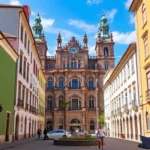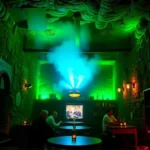Visit Casa Milà: Things to See, Tips and Experience

Are you planning a visit to Barcelona and looking for a unique architectural experience? Or perhaps you are a resident who hasn’t yet explored this masterpiece? This article dives deep into one of Antoni Gaudí's most iconic creations, Casa Milà, better known as La Pedrera. We will explore its fascinating history, uncover intriguing facts, and share our own experiences, along with essential tips for your visit.
an ultimate guide to visiting la pedrera
La Pedrera stands as one of Barcelona's most recognizable buildings, perfectly situated on the illustrious Passeig de Gràcia. You can’t miss its remarkable undulating white facade, a testament to Gaudí's genius. This architectural wonder not only captivates the eye but also invites you to delve into its storied past.
a brief history of casa milà
Constructed between 1906 and 1912, Casa Milà was Gaudí's last significant civil project before he devoted himself entirely to the Sagrada Familia. This building broke away from conventional architectural norms, showcasing an innovative, organic design that many of Gaudí's contemporaries found perplexing.
To understand the significance of La Pedrera, we must travel back to early 20th-century Barcelona. At that time, Passeig de Gràcia had become the hub for the city's bourgeoisie, and Pere Milà, a wealthy businessman, commissioned Gaudí to construct a residence for his family. The ensuing collaboration, however, was anything but smooth.
Initially, Gaudí faced numerous challenges, including conflicts with the Milà family and regulatory hurdles imposed by the city council, which often led to fines. The tensions escalated to a point where the Milàs refused to pay Gaudí, resulting in a legal dispute that he ultimately won, donating the fees to charity.
For more detailed insights into the history of La Pedrera, check out this detailed timeline.
what to see at la pedrera
Recognized as a UNESCO World Heritage Site in 1984, La Pedrera attracts around one million visitors annually. If you're among those eager to explore, here’s what you can expect during your visit.
› the façade
The most striking feature of La Pedrera is undoubtedly its facade. Composed of white stone with curving forms that mimic ocean waves, it features 32 unique wrought-iron balconies. Surprisingly, when it was inaugurated, many critics ridiculed its unconventional structure, with some even depicting it as a zeppelin garage in satirical cartoons.
The nickname "La Pedrera," which means "the quarry" in Catalan, originated from this very facade, reflecting its rocky appearance. Despite initial criticism, the building has since become an architectural icon.
› the neighbor's apartment
One of the highlights of the visit is the “Neighbor's Apartment” located on the fourth floor. It provides an authentic glimpse into the lifestyle of the early 20th-century bourgeoisie. The interior is meticulously preserved with original furniture, flooring, and decor, offering a fascinating time capsule of the era.
› the attic of the whale
The attic, often referred to as the "Whale's Attic," features 270 brick arches, creating an otherworldly environment reminiscent of a whale's skeleton. Here, you'll find an engaging exhibition dedicated to Gaudí's work, illustrating his innovative construction techniques and his inspiration drawn from the natural world.
› the warrior's rooftop
The rooftop is where the magic truly happens. Famous for its warrior-shaped chimneys, it offers breathtaking 360-degree views of Barcelona. Even if you’ve seen photos, standing amidst these fascinating structures is a surreal experience. The design reflects Gaudí's ability to blend artistry with functionality.
› the patios
During your exploration, you'll encounter two stunning patios:
- Butterfly Patio: Named for its entrance that resembles a butterfly's wing, this central courtyard is surrounded by apartments and features a staircase reminiscent of a lizard's back, showcasing Gaudí's affinity for nature.
- Flower Patio: Accessible through a grand entrance that once allowed cars to enter the underground parking, this patio leads directly to the main living areas of the building.
› café de la pedrera
Don’t miss out on the Café de La Pedrera, which adds another layer to your visit. Enjoy a delightful meal or a simple coffee while soaking in the ambiance. The café often features live music, enhancing the atmosphere.
how to visit la pedrera
If you haven’t purchased tickets yet, head to the ticket booth located at the front of La Pedrera on Carrer Provença. If you’ve already booked your tickets online, go to the designated entrance nearby.
Upon passing through security, you will find yourself in the Butterfly Patio. From there, you’ll pick up your audio guide, which activates as you move through the exhibits. Gaudí installed two elevators in the building, showcasing his forward-thinking design.
Your journey will take you through the Neighbor's Apartment, allowing you to immerse yourself in the past. Afterward, you’ll explore the Whale's Attic, where you can learn about Gaudí’s methods and view models of his other works, including the Sagrada Familia.
Finally, you’ll ascend to the rooftop, where you can marvel at the views and the unique chimneys before descending back to the patios. The entire visit typically takes about 1.5 hours.
does it worth visiting la pedrera?
Absolutely! La Pedrera is not just an architectural marvel but a cultural landmark that embodies Barcelona's artistic spirit. Here are some practical tips to ensure you make the most of your visit:
› ticket prices and types
Before heading to La Pedrera, familiarize yourself with the different types of visits available:
- Essential: This standard entry allows you to explore the main areas of the building for €25.
- Complete: Includes a virtual visit using cutting-edge technology for €35.
- Sunrise: Early access before general opening hours with a guided tour (in English) for €39.
- Night Experience: A night visit culminating in a stunning rooftop videomapping for €35.
All tickets include an audio guide in multiple languages. Note that purchasing tickets at the booth incurs an additional €3 surcharge. To avoid this, consider buying online.
› getting to la pedrera
La Casa Milà is located at Passeig de Gràcia 92 (near Carrer Provença). The best way to reach it is via metro, with stations at Diagonal (lines 3 and 5) or Passeig de Gràcia (lines 2, 3, and 4). Also, there are several bus lines and Renfe commuter train services available nearby.
› visiting hours
- Monday to Sunday: 9:00 AM – 6:30 PM
- Nocturnal tours: 7:00 PM – 10:00 PM
- Sunrise sessions: 8:00 AM – 9:00 AM
- Closed on December 25 and from January 9 to 15 (for maintenance)
Always check the official website for the most current hours.
› best time to visit la pedrera
The ideal times to visit are right when it opens at 9:00 AM or in the early afternoon (between 2:00 PM and 4:00 PM) when crowds are lighter.
Have you had the chance to explore Casa Milà? If not, we hope this guide inspires you to visit. It is a unique experience that intertwines art, architecture, and history in one of Barcelona's most cherished landmarks.
Discover more about Barcelona and plan your visit wisely!


Deja una respuesta